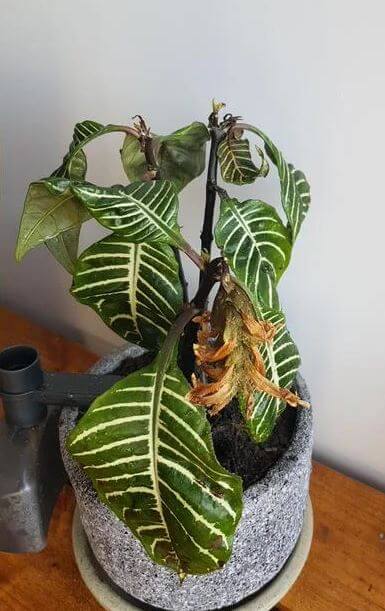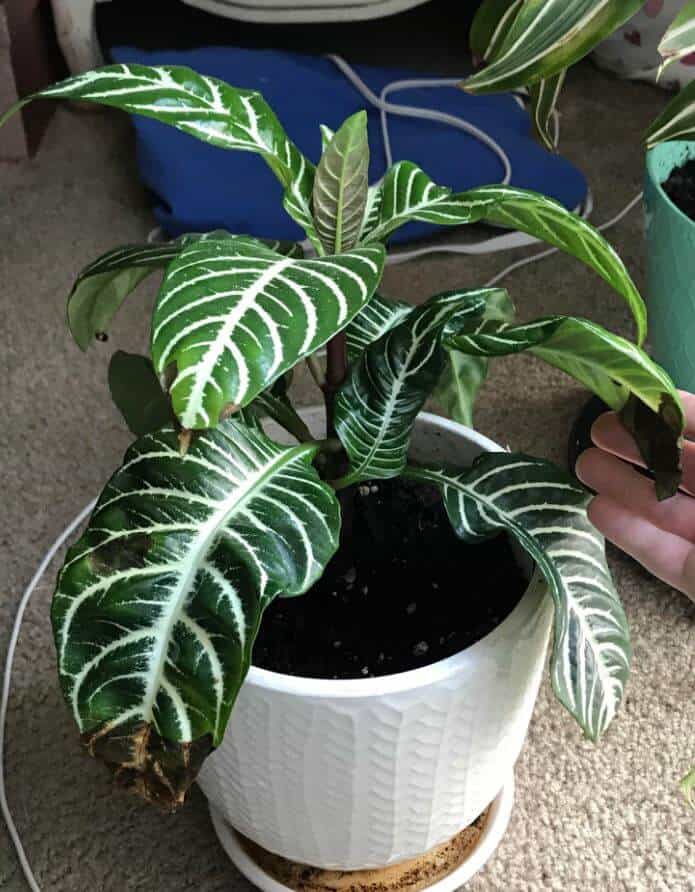Last Updated on July 3, 2023 by a Friendly Gardener
The Aphelandra squarrosa, better known as the ‘Zebra Plant’ or ‘Haworthia Zebra Plant’ is a popular houseplant hailing from Brazilian Atlantic forests. Unique for its eye-catching leaf patterns resembling the zebra, this houseplant requires some care to keep it happy and flourishing. If proper environmental conditions are provided, it will grow and thrive adding a bright conversation piece to your office or home décor.
Considered to be a bit of a temperamental diva, the Zebra plant is susceptible to leaf tips and edges turning brown. Due to the vividness of its foliage color, this will immediately become apparent, negatively influencing your plant’s aesthetics.
Why Are the Tips of My Zebra Plant Turning Brown?

Zebra plant brown tips are not usually an indication of disease but of a watering problem. When tips and edges turn born this may indicate that your plant’s root system is not receiving sufficient water, or your plant may be overwatered.
A well-draining soil blend, together with a container with enough drainage holes will aid if overwatering is an issue. To verify why tips are turning brown, check the soil bed by poking it with your finger up to your second knuckle. If the soil feels dry, it’s time to water. If the soil bed is damp, put off watering again for several more days.
Much will depend on where your plant is located. In a dry area, you may need to water more often whereas in the cooler seasons watering should be reduced. If the edges are browning and crispy, your plant may not be receiving adequate water.
Zebra Plant Leaves Turning Brown
There are a variety of environmental causes that can cause zebra plant brown leaves. Here are the most common.
Excess Sunlight Exposure
As a tropical succulent, the Zebra plant does not like direct sunlight which leads to increased transpiration. This creates the conditions for leaves to scorch and turn brown.
What to Do
Move your plant to a location where it will receive generous amounts of bright but indirect light such as a north-facing window perch. If you are cultivating your Zebra plant outside, make sure that it has shade such as a spot where other, taller vegetation provides a canopy protecting from direct sunlight.
Improper Containers

If your Zebra plant is root bound in a container that is too small, the leaves will turn brown.
What to Do
Repot your Zebra plant annually to prevent this from happening selecting a new container that is an inch or two larger than the current one.
Improper Environmental Temperatures
Zebra plants prefer room temperatures that measure between 65° and 75° F. If temps fall below 55° F, this can harm the plant as can temps that rise above 80° F due to the rapid evaporation of the plant’s moisture causing leaf tips to turn brown. Also beware of drafts from doors, windows, air condition units, or heating vents.
What to Do
The best option is to find a spot where the environmental temperature measures approximately 70°F.
Improper Soil

The soil bed you provide for your plant will influence its overall health. Soil mixes that are poor in organic matter tend to become hydrophobic meaning that there will be a lack of moisture retention. Hydrophobic soil beds also form a wax-like residue on the soil bed surface which impedes water penetration. If the Haworthia plant does not receive adequate water, the foliage will turn brown.
What to Do
You may want to repot your plant in a better soil mix with some sphagnum moss mixed in to aid moisture retention. You can also mulch using organic materials such as wood chips, hay, pine bark, or compost. Experts recommend using organic materials for mulching as they also contribute to the plant’s nourishment.
Other plant experts suggest using commercial wetting agents or commercially available Mycorrhizae fungi that aid plant root systems in absorbing nutrients and retaining moisture available in nurseries.
Soil pH should be neutral to acidic.
Low Humidity
Zebra plants not only boast distinct leaf patterns but textured foliage as well. If humidity levels fall below 30%, leaves will begin to wilt and cause brown tips on the Zebra plant.
What to Do
Ideally, environmental humidity for the zebra plant should measure between 40% and 80%, therefore air vents or others that can vary these levels should be kept at a distance from your plant. You can use a space humidifier or a pebble tray beneath your plant’s container. Misting is also a possibility but you should not allow water to remain on leaves as this can contribute to leaf spot disease.
Overfertilization
All houseplants can benefit from a nutrient boost, but it’s better to use a fertilizer that is formulated for the type of plant you are cultivating. If you do not feed your plant occasionally, it may not flourish as much as you would like, but overfeeding is much more damaging. Overfertilization can cause foliage yellowing, wilting, stunted growth, and brown leaf tips. It also can lead to a buildup of salts in the soil bed which can prevent water absorption and chemically burn roots.
What to Do
Do not feed your plant in the winter. In the spring and summer, feed your plant with a diluted liquid fertilizer after you have watered it. Do not feed fertilizer to a plant sitting in a dry soil bed. Select a liquid fertilizer formulated for foliage and flowering plants.
Soggy Soil and Overwatering

If your plant is potted in a compact, heavy soil blend, water will not be able to drain quickly. Likewise, if you have been overwatering, it stands to reason that your plant is sitting in a waterlogged soil bed.
One symptom is when leaves begin to brown in the middle together with tips. Permitting this condition to continue will eventually lead to root rot and the death of your plant.
What to Do
Begin by ensuring that your plant’s container has drainage holes and that they are not blocked. If this proves to be insufficient, you probably need to repot with fresh well-draining potting soil because the soil has compacted impeding proper drainage. Add perlite or pumice to the soil mixture to guarantee aeration of the soil and drainage. You can blend your soil using two parts potting soil, one part perlite, one part sphagnum moss, and one part sand.
Underwatering

As a succulent, incorrect water can place this plant in danger. Forgetting to water or underwatering will dry out the root zone so that the Haworthia plant does not have sufficient moisture for photosynthesis. Leaves will begin to brown.
What to Do
If your plant’s soil bed has dried out completely, do a deep soak until water runs out of drainage holes. Remember that watering needs will vary with the seasons, so what is sufficient in winter will not be adequate in the summer.


